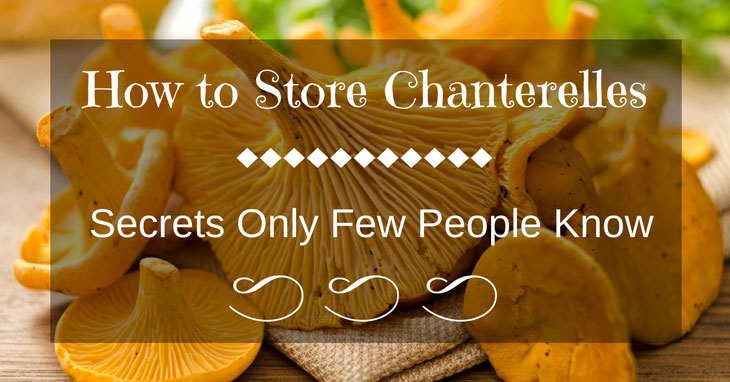How to Store Chanterelles: Secrets Only Few People Know
Chanterelles are among the prized mushrooms of many people including restaurant chefs. And this is for a good reason. They are among the most delicious and versatile fungi that you can add to a wide variety of dishes. However, Chanterelles are only available for several months of the year. If you want to enjoy them year-round, the best way is to preserve and store them. But how do you properly store Chanterelles?
In this guide, I will show you some of the techniques to extend the shelf life of Chanterelle mushrooms so that you can enjoy them even after the harvest season.
More...
What are Chanterelles?
Chanterelles are meaty edible mushrooms that abundantly grow in the wild especially in the West Coast and temperate forests around the world. It is a meaty and edible mushroom with a color that ranges from orange to gold.
They are considered as the “Queen of the Forest” as they are popular in many countries where they abundantly grow. They have an aroma comparable to apricots, but their flavor is hard to describe. Some say they have a nutty or fruity flavor with a slightly peppery taste. However you describe its taste, it is considered a delicious treat.
Chanterelles grow in most US states except Hawaii as well as in temperate forests around the world. Its harvest season starts in July through January. It is possible to grow Chanterelles but many still prefer to harvest them in the wild.

Foraging for Chanterelles
Knowing where Chanterelles grow is key to a good morning’s harvest. When they are in season, Chanterelles normally grow in clusters on the forest floor in the middle of decaying moss, wood and pine needles.
The best place is where there are mixed hardwood trees such as oak, beech, maple, birch and poplar trees. They prefer places where there is a light canopy overhead.
If you are in the Deep South, you’d probably find many Chanterelle growing under blueberry bushes. You can also find them growing in moist habitats especially along creek beds or where water flows after a rainfall. Oftentimes, you will see them in the company of other mushrooms, some edible while others may not be.
Chanterelle mushrooms are very prolific and have distinct features that make them relatively easy to find. However, inexperienced foragers may not be able to distinguish them from their look-alikes, one of which is the Jack O' Lantern or the false Chanterelle. It is not a fatal mushroom but it may cause upset stomach, diarrhea and cramps.
If you haven’t foraged for Chanterelles before, it is best if you go with someone who is an experienced Chanterelle mushroom hunter. That way, you’ll avoid gathering and storing the wrong mushrooms. You may also watch this video to learn more about how Chanterelles look.
If you have gathered a good number of Chanterelles, you can then preserve or store them to extend in many ways.

Methods of Storing Chanterelles
While most mushrooms dry well, Chanterelles don’t. They lose a lot of their umami flavor when dried. They also become leathery. Thankfully, there are many other ways to preserve or store Chanterelles.
#1 Pickling
This pickled Chanterelle mushroom recipe is made by Hank Shaw and published in honestfood.net
- Preparation Time: 20 minutes
- Cooking Time: 20 minutes
- Total Time: 40 minutesS
- Serving: 2 pints
Ingredients:
- 1 to 1 1/2 pounds chanterelles or other mushrooms
- 2 cups white wine vinegar
- 1/2 cup water
- 1/3 cup sugar
- 2 bay leaves
- 2 teaspoons dried thyme1 teaspoon black peppercorns
Instructions:
1. Get your canning gear ready and a large pot of hot water. Clean your mushrooms of any dirt, mold or wet spots. Cut large ones in half and keep small chanterelles whole.
2. Dry sauté the mushrooms in a large frying pan. When they give up their water, sprinkle 1 tablespoon of salt on them along with the thyme. Once the chanterelles have given up most of their water, pour over the rest of the ingredients and bring to a boil. Turn the temperature down to a simmer and cook for 5 minutes. Turn off the heat.
3. Fish out the mushrooms and pack them firmly into jars, leaving at least 1/2 inch of headspace. Make sure each jar gets a bay leaf and some peppercorns.
4. Ladle in the cooking liquid. Make sure it covers the mushrooms. Add more white wine vinegar or distilled vinegar to top off if necessary. Wipe the rims of the jars and seal. Process in a boiling water bath for 15 minutes.

#2 - Freezing
Freezing is another good method of preserving and storing Chanterelles. They will last longer if they are cooked first before freezing. There are 3 ways to do it:
- Sautéing and Freezing
To do this, you need to clean the Chanterelles first. You could chop or leave them as is. In a skillet over medium heat, melt a little butter and then add the Chanterelles. Stir them occasionally. After the Chanterelles release their juices, wait until they reabsorb them. This process could take about 10 minutes. Let the mushrooms cool before putting in a container to freeze.
Sautéing is a good idea if you are working in small batches.
- Dry Frying and Freezing
Dry frying is similar to the above procedure except that you don’t use butter. Instead, you should use a nonstick skillet. Heat it over a medium fire then add your Chanterelles. Add a bit of salt to taste. Cover the skillet with a lid and then set your stove to high. Stir the mushrooms occasionally. Continue to cook until there is no more liquid. Let it cool, put in a container then freeze.
- Steaming and Freezing
Steam the Chanterelles just like you usually do when you steam other dishes. Cover and leave it for about 10 minutes. Remove the Chanterelles from the steamer and let it cook. Place them in containers to freeze.

#3 - Canning
Canning is also a good way to store Chanterelles. I found a good recipe at the Let the Baking Begin and thought of sharing it to you.
Ingredients:
- 4 lbs Chanterelles1 tbsp sugar
- 1.5 tbsp salt1 cup baby carrots
- 1 large onion, peeled & cut into quarters
- 10 black peppercorns
- 4-5 cloves garlic
- Vinegar
Special Equipment:
- 3-4 1 qt Mason Jars
- 3-4 Mason Lids
- Pressure Cooker
Instructions:
1. Wash the mushrooms under running water and clean them from any kind of debris. Bring 2 large pots of water to a boil while cutting mushrooms.
2. Cut large mushrooms into one- to two-inch chunks (the mushrooms will shrink once cooked) and place into a large pot.
3. Cover with water and allow to come to a boil. Cook for 4-5 minutes.
4. Remove the mushrooms with a sieve into a different container. Discard the water. Rinse the pot.
5. Place the mushrooms back into the pot and add enough liquid to barely cover the mushrooms.
6. Add the sugar and salt. Stir until dissolved.
7. Distribute the mushrooms into the jars leaving about 2 inches of space.
8. Add garlic clove, a couple of baby carrots, about 1/4 of onion and 3-4 peppercorns to each jar and 1 teaspoon of vinegar to each jar.
9. Close with a lid (do not tighten), place into a pressure cooker and fill with water to cover the jars by about 2 inches. Cook for 40 minutes from the time the pressure reaches 10 lbs of pressure on the gauge.
10. Take the pressure cooker off the heat and open the lid according to the package instructions that went with your pressure cooker. Do not just open it. Once the jars are out of the water, tighten the lid and allow to cool. Mushrooms are ready to be moved to a storage area.

Conclusion
Chanterelles are among the popular mushrooms because of their taste. While you can’t have fresh Chanterelles all year round, you can still enjoy them with the different methods of preserving and storing we listed above. But before you do that, be sure that what you have are really Chanterelles and not the look-alike Jack O’ Lanterns.
References:
https://www.thespruce.com/how-to-preserve-chanterelle-mushrooms-1327669
https://katepavelle.wordpress.com/2013/07/17/chanterelle-preservation-methods/
http://wild-harvest.com/chanterelle-mushrooms/
http://www.specialtyproduce.com/produce/Chanterelle_Mushrooms_705.php
https://www.forestmushrooms.com/pages/foraged-products-now-in-season
Did this article help you? Please share with us your thoughts through the comments. You may also share this article with your friends if you know it could help them.

